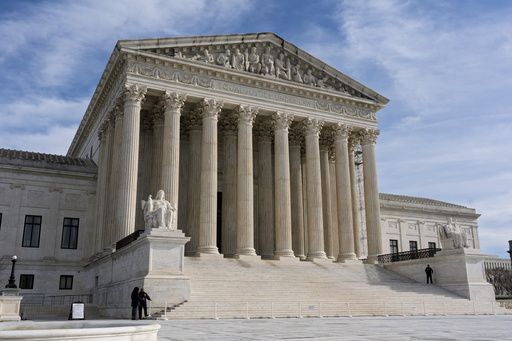
WASHINGTON — President Donald Trump is looking to the Supreme Court, featuring three justices of his own selection, to support a series of bold moves he’s made early in his second term. However, even with a conservative majority that typically champions executive authority, some of Trump’s goals might face resistance.
Last year, the Supreme Court afforded Trump significant victories that cleared the path for his reelection efforts, such as postponing his criminal trial in Washington, D.C., and granting him immunity from legal action regarding official duties. In contrast, his first term was marked by notable losses in addition to successes at the high court.
“The Roberts Court faces a unique challenge as it decides whether to uphold constitutional values it has historically supported,” remarked Michael Waldman, who leads New York University’s Brennan Center. He expressed confidence that the Court would intervene against what he described as overtly unconstitutional initiatives, yet he also raised concerns about the president’s expanding authority.
The Supreme Court may find itself addressing numerous pressing issues. Current lower court rulings are already challenged on topics such as birthright citizenship, restrictions on federal grants, and orders concerning the federal government workforce. Additionally, litigation surrounding limitations on transgender rights, measures affecting asylum-seekers, efforts to dissolve USAID, and controversies involving access to sensitive data by Elon Musk’s team are making their way through the legal system.
Trump’s track record at the Supreme Court during his initial term was mixed. He faced scrutiny over his travel ban from various primarily Muslim countries, which was ultimately upheld only after two of its iterations were blocked by lower courts. The justices did align to approve his administration’s maneuver to dismiss the head of the Consumer Financial Protection Bureau and permitted the redirection of Pentagon funds to construct parts of a border wall while the legality of those actions remained unresolved.
Nonetheless, Trump also suffered setbacks. Chief Justice John Roberts sided with the Court’s liberal justices to prevent the termination of the DACA program that shields young immigrants, as well as to stop the inclusion of a citizenship question on the 2020 census. Moreover, Roberts publicly chastised Trump for labeling a judge who ruled against his asylum policies as an “Obama judge.”
A significant shift since Trump’s first presidency stems from the current composition of the Court, which now only includes three liberal justices. This change was catalyzed by the passing of Ruth Bader Ginsburg, which allowed Trump to appoint Amy Coney Barrett, who joined two of his previous appointees, Neil Gorsuch and Brett Kavanaugh.
The topic of birthright citizenship is expected to be an early challenge. Trump has proposed an executive order to revoke this status for children of undocumented immigrants, facing an immediate legal barrier. His administration suggests it will appeal a prior judicial ruling that halted this action. The urgency could lead to a Supreme Court appeal if the federal appeals court expedites its proceedings.
Legal experts are divided on the viability of Trump’s initiative. The dominant viewpoint among scholars — both liberal and conservative — is that this particular challenge may not succeed. “I am quite doubtful that there would be support for the birthright citizenship order as it stands,” commented Jonathan Adler, a law professor at Case Western Reserve University, expressing skepticism despite his more conservative stance.
Conversely, Trump’s initiative to suspend federal funding and disband USAID might also encounter scrutiny, even from a generally conservative court, although some lesser reductions may stand a better chance. “The Court may adopt a cautious stance, especially concerning efforts to dismantle an established agency,” said Michael Moreland, a law professor who served in the George W. Bush administration.
Historical context, particularly regarding the travel ban that was ultimately upheld after several revisions, informs this anticipated pushback. “Often, bold declarations come first, followed by a retreat to more defensible positions in the face of backlash, resulting in more moderate yet still impactful outcomes,” Adler noted.
In terms of authority to terminate appointments, Trump is likely on more solid ground regarding the dismissals of National Labor Relations Board member Gynne A. Wilcox and Equal Employment Opportunity Commission members Charlotte Burrows and Jocelyn Samuels, who are both Democrats. Wilcox has already filed suit, claiming that current laws shield her from arbitrary dismissal.
However, even her legal representatives have conceded that her case may lead to a Supreme Court review of a long-standing precedent from nearly a century ago, established in Humphrey’s Executor, which protected certain federal agency officials from being dismissed without cause by the president. This doctrine, however, clashes with a legal theory gaining traction among conservatives, which asserts that ultimate executive power resides solely with the president, who is accountable to the electorate.
While Roberts upheld the foundational aspects of this precedent, he has also eroded its impact, despite dissenting views from Justices like Clarence Thomas and Gorsuch, who would prefer to see it overturned entirely. “If I had to predict, I would anticipate that the existing precedent could either be significantly curtailed or outright rescinded,” Moreland concluded.

